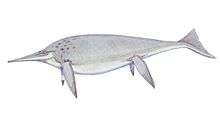Quasianosteosaurus
| Quasianosteosaurus Temporal range: Early Triassic, 249–247.2 Ma | |
|---|---|
| Scientific classification | |
| Kingdom: | Animalia |
| Phylum: | Chordata |
| Class: | Reptilia |
| Order: | †Ichthyosauria |
| Family: | †Quasianosteosauridae Maisch & Matzke, 2003 |
| Genus: | †Quasianosteosaurus Maisch & Matzke, 2003 |
| Type species | |
| †Quasianosteosaurus vikinghoegdai Maisch & Matzke, 2003 | |
Quasianosteosaurus is an extinct genus of basal ichthyosaur known from the late Early Triassic (late Olenekian stage) of Spitsbergen of the Svalbard archipelago, Norway. It was first named by Michael W. Maisch and Andreas T. Matzke in 2003 and the type species is Quasianosteosaurus vikinghoegdai. The generic name is derived from Latin quasi, "almost", and Greek anosteos, "boneless" and sauros, "lizard", in reference to the preservation of the holotype which is almost exclusively a natural cast of the skull with very little original bone. The specific name is derived from Vikinghøgda, "Mount Viking", where the holotype was found. Quasianosteosaurus is known only from the holotype MNHN Nr. SVT 331, a partial three-dimensionally preserved skull consisting of the snout and orbital and postorbital regions. The skull is by far the largest Early Triassic ichthyosaur skull known, with estimated cranial length at 50 cm (20 in). It was collected from the lowermost Grippia Niveau of the Sticky Keep Formation (Spathian substage), Sassendalen Group at Mount Viking, Sassendalen. A phylogenetic analysis performed by Maisch & Matzke (2003) found it to be a basal ichthyosaur, sister taxon to Hueneosauria.[1]
References
- ↑ Michael W. Maisch and Andreas T. Matzke (2003). "Observations on Triassic ichthyosaurs. Part XII. A new Early Triassic ichthyosaur genus from Spitzbergen [sic]". Neues Jahrbuch fur Geologie und Palaontologie, Abhandlungen. 229 (3): 317–338.

